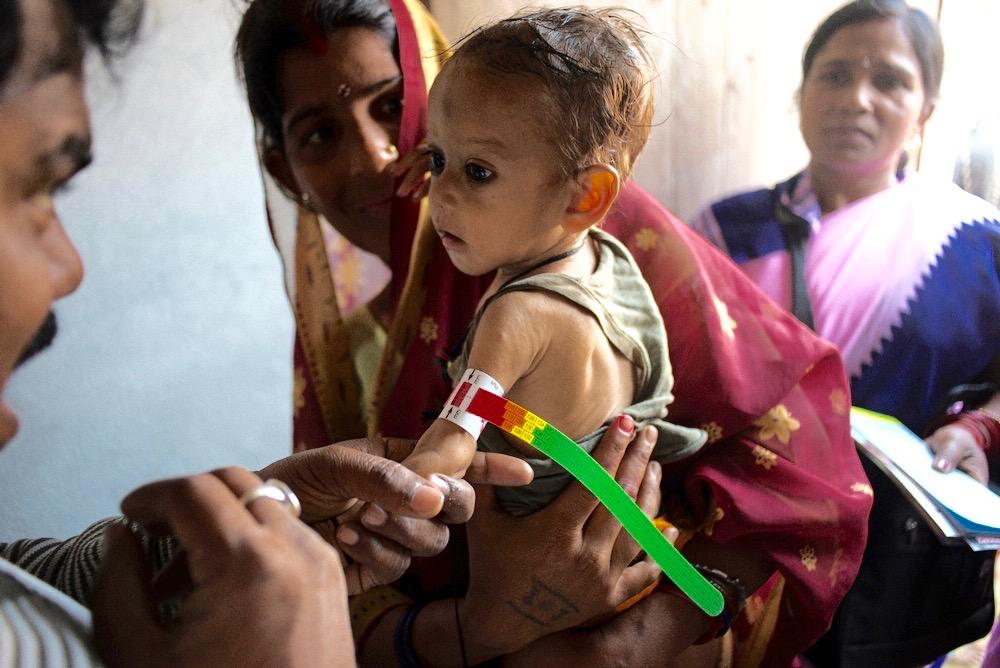The Global Malnutrition Epidemic: A Human Rights Agenda
archive

The Global Malnutrition Epidemic: A Human Rights Agenda
Nearly 800 million people worldwide remain chronically undernourished, and over two billion suffer from micronutrient deficiencies, also known as hidden hunger. Another two billion are overweight, with 600 million of these being obese. Meanwhile some 159 million children under five years of age are stunted, approximately 50 million children from this same age bracket are wasted, and 42 million are obese. For the first time in human history, there are more obese than underweight adults in the world. As a result, noncommunicable diseases (NCDs) associated with obesity have surpassed undernutrition as the leading cause of death in low-income countries.
These figures indicate that the challenges of malnutrition in all its forms are daunting. Nevertheless, in many developing and least developed countries (LDCs), policies against hunger receive more attention than does the prevention of malnutrition in general, or the stunting and wasting of children. Therefore it is important to emphasize that the right to adequate food includes nutrition. “Adequacy” with respect to food simply embraces nutritional value. This means that the quality of the food we consume has to become as important as the quantity. It is not enough to provide quantities of food as measured by caloric intake to eliminate hunger. This caloric intake must include the necessary ingredients for human health.
Like access to food in general, access to nutritious food is often a key indicator of economic inequalities, as well as of discrimination. Therefore including nutrition in a rights-based framework is critical to ensuring that marginalized and vulnerable segments of the population are able to access adequate, healthy, and nutritious food. Despite recent well meaning initiatives and an existing framework for action, there are several barriers to implementation. Poverty, social exclusion, gender inequality, low socio-economic status and lack of control over productive resources (issues such as land grabbing and seed patenting) are all major contributors to malnutrition. Similarly, malnutrition is aggravated by poor sanitation and the absence of safe drinking water and adequate housing, as well as a lack of education, health and social protection services in many societies.

Besides all these economic and social determinants, the current food systems are based on industrial agriculture involving the dominance of few big food companies and supermarket chains that systematically contribute to resource scarcity and environmental degradation, as well as unsustainable production and consumption patterns, food losses, waste, and distribution imbalances.
The legal duty to provide access to adequate nutrition
International law instruments provide a normative and legal foundation for the human right to adequate food and nutrition. There are several human rights documents that support the claim that the right to adequate food and nutrition is not only legitimate, but constitutes a legal duty. The clear inclusion of a focus on nutrition is revealed, for example, in the “right to adequate food” of Article 11 of the ECSR Covenant (International Covenant on Economic, Social, and Cultural Rights), closely linked to the “right to health” of the Covenant’s Article 12.1, which recognizes “the right of everyone to the enjoyment of the highest attainable standard of physical and mental health.” If nutritious food is not sufficiently available and accessible, there will be adverse consequences for physical and mental health.

In its General Comment 12, Paragraph 14, the Committee on Economic, Social and Cultural Rights (CESCR) interpreted the right to adequate food as follows: “Every State is obliged to ensure for everyone under its jurisdiction access to the minimum essential food which is sufficient, nutritionally adequate and safe, to ensure their freedom from hunger.” Furthermore, General Comment 14 Paragraph 43 (b) reiterates that one of the core state obligations under the right to health involves ensuring “access to the minimum essential food which is nutritionally adequate and safe, to ensure freedom from hunger to everyone.”
The FAO’s Voluntary Guidelines to Support the Progressive Realization of the Right to Adequate Food in the Context of National Food Security (Voluntary Guidelines, 2004) notes that “States should take measures to maintain, adapt or strengthen dietary diversity and healthy eating habits and food preparation, as well as feeding patterns, including breastfeeding, while ensuring that changes in availability and access to food supply do not negatively affect dietary composition and intake.”

Besides the universally protected right to food and nutrition for all, further protections have been adopted for children, pregnant and lactating women due to the fact that malnutrition does more harm to these populations, especially poor women and children. Article 24 of the Convention on the Rights of the Child (CRC) acknowledges that to pursue the full implementation of “the right of the child to the enjoyment of the highest attainable standard of health…” states “shall take appropriate measures to (c) combat disease and malnutrition… through, inter alia… the provision of adequate nutritious foods.” Article 27(3) states that: “Parties… shall take appropriate measures to assist parents and others responsible for the child to implement this right and shall in case of need provide material assistance and support programmes, particularly with regard to nutrition, clothing and housing.”
The Committee of the CRC in its General Comment on Article 24 calls on states to ensure that all segments of society are informed of the advantages of breastfeeding. The protection and promotion of breastfeeding is also enshrined in the International Code on Marketing of Breast-milk Substitutes, which was adopted by the World Health Assembly in 1981. The Global Strategy for Infant and Young Child Feeding, adopted in 2002, sets out the obligations of states to develop, implement, monitor and evaluate comprehensive national policies addressing infant and young child feeding, accompanied by a detailed action plan.
The 1979 Convention on the Elimination of All Forms of Discrimination Against Women (CEDAW) highlights the importance of children, as well as the importance of lactating and pregnant women. Article 12 stipulates that all states shall ensure to women appropriate services in connection with pregnancy, confinement and the postnatal period, granting free services where necessary, as well as adequate nutrition during pregnancy and lactation. Unfortunately, CEDAW fails to fully protect a woman’s right to adequate food and nutrition as an individual, but only provides protection within the parameters of pregnancy and breastfeeding. It is vitally important to correct this protection gap as soon as possible.
...including nutrition in a rights-based framework is critical to ensuring that marginalized and vulnerable segments of the population are able to access adequate, healthy, and nutritious food.
The role of private sector
Considering the pivotal role of the private sector in the provision of adequate food and nutrition, it is appropriate that the primary role of regulating and monitoring the private sector should be given to governments. A human rights framework underlines the responsibility of corporations that produce food and shape nutritional standards to respect human rights and to contribute to equitable access to nutritious foods for all persons. Such responsibility is implied in the Universal Declaration on Human Rights, which clearly asserts that “everyone has duties to the community” (Art. 29), and that groups and persons must refrain from activities causing encroachment on the rights enshrined within the Declaration (Art. 30).
In 2011 the UN Human Rights Council endorsed the UN Guiding Principles on Business and Human Rights, formally recognizing the responsibility of enterprises to avoid infringing on the human rights of others and to address adverse human rights impacts arising from their commercial activities. This responsibility extends to the adverse impacts caused by the food industry in relation to the right to adequate food.

Although there is no significant resistance opposing a human rights approach to adequate food and nutrition, several potential barriers exist that affect proper implementation. As indicated earlier, the impact of industrial food systems on nutrition and public health is alarming. These systems focus on increasing food production and maximizing efficiency at the lowest possible economic cost and highest profitability.
They therefore rely on mono-cropping, factory farming, industrial food processing, mass distribution and aggressive marketing that promotes the affordability and availability of their products. The marketing strategies of these industrial producers generate a very significant portion of the world’s food sales. More importantly, trade liberalization and foreign direct investment by transnational corporations in the processed food industry have played a large role in increasing the availability of ultraprocessed (junk) foods that are marketed globally.
These corporations furthermore pose a challenge to the policymaking process itself. Although the private sector has a role in fighting malnutrition, there is a danger in giving corporations unprecedented access to policymaking processes under the banner of “multi-stakeholder partnership,” since it may generate conflicts of interest at numerous levels unless governed properly. Moreover, corporations greatly prefer voluntary commitments to regulatory frameworks, which often results in lax implementation.
At both the domestic and international levels, we see other forms of corporate intransigence, such as their resistance to labeling, taxing, and limiting excessive advertisements for junk foods, which covers highly processed foods containing excessive amounts of salt, sugar and saturated fats. Then there is a governance problem, since nutrition poses a multifaceted challenge that needs to be coordinated through the cooperative effort of several parts of government machinery. Finally, the complex character and long-term impacts of malnutrition on human health, as well as the absence of indicators and lack of robust data, creates difficulties when it comes to establishing workable monitoring, accountability and transparency mechanisms. Taken together, these issues pose significant challenges that must be addressed if the human rights to decent nutrition are to become truly operational on a global scale.
This article is adapted from Dr. Elver’s Foreword to Good Nutrition: Perspectives for the 21st Century. M. Eggersdorf, K. Kraemer, J.B. Cordano et al, eds. Basel: S. Karger, 2016.




